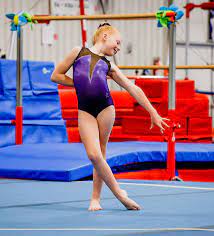Gymnastics for kids offers a fun, high-energy introduction to movement, coordination, and physical confidence. If you’re enrolling your child in their first gymnastics class, you might be wondering what the day will look like, what they need to bring, and how they’ll feel in a brand-new environment. Here’s exactly what to expect — from check-in to cool-down — to help you and your child feel more prepared and excited.
What happens in the first gymnastics class?
At most gymnastics centres, your child’s first class begins with a quick check-in at reception, followed by a short introduction to the coach and group. Expect a warm, welcoming atmosphere where kids are encouraged to explore and learn at their own pace.
Here’s a basic breakdown of a beginner class:
- Welcome and warm-up (5–10 minutes): Light stretches, running games, or animal walks to loosen up.
- Skill stations (20–30 minutes): Kids rotate through basic activities like balancing on a beam, forward rolls, monkey bars, and mini trampolines.
- Cool-down (5 minutes): Group games, breathing, and light stretching to finish.
All activities are age-appropriate and designed to build foundational skills like balance, strength, and coordination while keeping it playful and social.
What should my child wear to gymnastics?
Comfort is key. Kids should wear fitted activewear, like leggings or shorts and a t-shirt or leotard. Avoid anything with buttons, zippers, or drawstrings. Bare feet are standard in most gyms to prevent slipping on mats and equipment.
Checklist for day one:
- Fitted activewear (leotard optional)
- Hair tied back securely
- Water bottle with name label
- Small bag or backpack (optional)
- No jewellery or watches
Having your child dressed appropriately will help them feel confident and allow them to move freely and safely through each station.
Will my child be grouped with others their age?
Yes — most gymnastics for kids programs structure classes by age group, and sometimes skill level. Grouping this way ensures kids are learning alongside peers at similar developmental stages. It also builds social confidence, as friendships tend to form quickly in these playful, team-like settings.
Instructors usually keep class sizes small to ensure each child gets enough attention and feedback, especially in beginner sessions.
How do coaches support beginners?
First-timers are given extra support during their introduction to gymnastics. Coaches are trained to guide children with kindness and patience, often using demonstrations, hands-on spotting, and simple instructions. Positive reinforcement is a big part of their approach — claps, high-fives, and praise help build trust and motivation.
Parents often notice their child grow more confident week by week, not just physically but emotionally, as they learn to follow instructions, wait their turn, and try new things without fear.
Will parents be able to watch?
This depends on the centre’s policy. Many gymnastics venues have a viewing area where parents can watch behind glass or from a distance. Some centres allow parents on the floor during early childhood sessions (usually ages 2–4), but for primary-aged children, the focus shifts to independent participation.
Watching from the sidelines is a great way to show support without interfering with the learning process. If your child knows you’re there cheering them on, it can boost their confidence without creating distraction.
What skills will they start learning first?
The initial focus is on body awareness, safety, and basic movement patterns. Your child won’t be doing flips on day one — instead, expect:
- Learning how to fall safely (a key skill in gymnastics)
- Basic rolls (forward, backward)
- Balancing on beams
- Hanging from bars
- Light bouncing on trampolines
These movements form the foundation for more advanced skills and are important for developing motor skills used in many other sports and everyday life.
How can I help my child feel confident before class?
New environments can be overwhelming, especially for younger kids. You can ease your child into their first gymnastics experience by:
- Talking through what will happen (“You’ll meet a coach, stretch, play some games, then do fun stuff on the bars and mats.”)
- Visiting the centre ahead of time if possible
- Practising simple stretches or animal walks at home
- Arriving 10–15 minutes early to settle in
- Encouraging them to try and have fun, not to “be perfect”
Social proof plays a subtle role here: kids often look to others in the group for cues. If other children are laughing and trying new things, your child is likely to follow along.
Is there anything I should know about safety?
Yes. Reputable gymnastics centres prioritise safety. This includes padded flooring, child-friendly equipment, and coach-to-child ratios that meet industry standards. Coaches are trained in spotting techniques and first aid, and class flow is designed to minimise risks.
If your child has any specific medical needs or anxiety, let the coach know beforehand. Communication helps tailor the experience to your child’s comfort level.
FAQs
Do kids need previous experience to join a beginner class?
No. Entry-level gymnastics for kids is open to all, with no experience required. Coaches start from the basics and work up gradually.
How long are beginner classes?
Most beginner classes for young children last 45–60 minutes. The pace is designed to suit short attention spans and avoid fatigue.
Can my child try a class before committing?
Many centres offer trial sessions or allow you to pay casually before enrolling in a term. It’s a good way to gauge your child’s interest without pressure.
Final thoughts
Starting gymnastics for kids is an exciting step that builds more than just physical skills — it nurtures confidence, resilience, and a love of movement. By knowing what to expect and preparing your child for their first class, you’re setting them up for a positive experience.
If you’re exploring structured children’s gymnastics programs, look for options that offer supportive coaching and a strong focus on skill development through play.
For more on child development through sport, you might also like this article from Raising Children Network.

